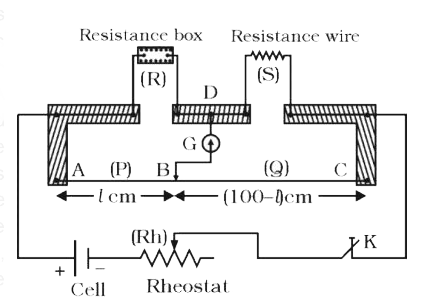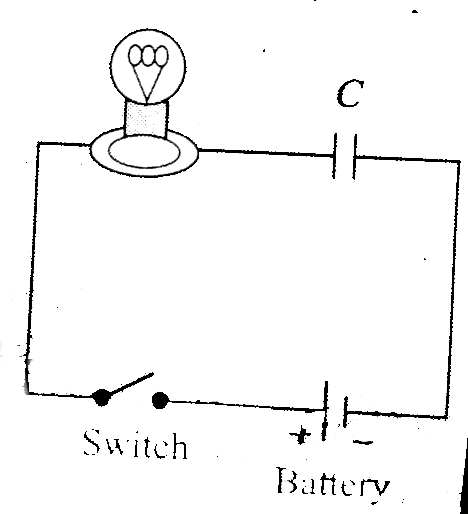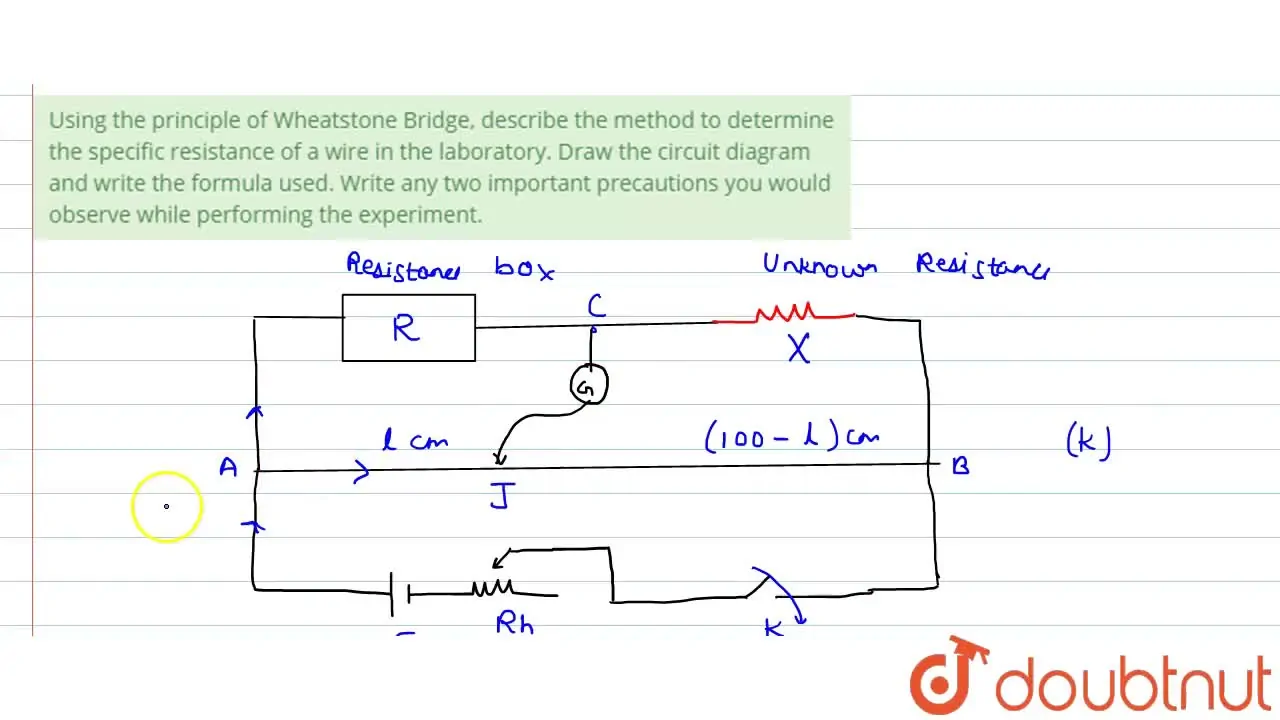Using the principle of Wheatstone Bridge, describe the method to determine the specific resistance of a wire in the laboratory. Draw the circuit diagram and write the formula used. Write any two important precautions you would observe while performing the experiment.
Metre Bridge: Special Case of Wheatstone Bridge
It is a device based on Wheatstone bridge to determine the unknown resistance of a wire. If ratio of arms resistors in Wheatstone bridge is constant, then no current flows through the galvanometer (or bridge wire).
Construction: It consists of a uniform 1 metre long wire AC of constantan or manganin fixed along a scale on a wooden base (fig.) The ends A and C of wire are joined to two L-shaped copper strips carrying connecting screws as shown in the figure. In between these copper strips, there is a third straight copper strip having three connecting screws. The middle screw D is connected to a sensitive galvanometer. The other terminal of galvanometer is connected to a sliding jockey B. The jockey can be made to move anywhere parallel to wire AC. By pressing the knob of jockey, it begins to touch the wire.
Circuit: To find the unknown resistance S, the circuit is complete as shown in fig. The unknown resistance wire of resistance S is connected across the gap between points C and D and a resistance box (R) is connected across the gap between the points A and D. A cell, a rheostat and a key (K) is connected between the points A and C by means of connecting screws. In the experiment when the sliding jockey touches the wire AC at any point, then the wire is divided into two parts. These two parts AB and BC act as the resistances P and Q of the Wheatstone bridge. In this way the resistances of arms AB, BC, AD and DC from the resistances P, Q, R and S of Wheatstone bridge. Thus the circuit of metre bridge is the same as that of Wheatstone bridge.
Method : To determine unknown resistance first of all key K is closed and a resistance R is taken in the resistance box in such a way that on pressing jockey B at end points A and C, the deflection in galvanometer is on both the sides. Now jockey is slided on wire at such a position that on pressing the jockey on the wire at that point, there is no deflection in the galvanometer G. In this position the points B and D are at the same potential, therefore the bridge is balanced. The point B is called the null point. The length of both parts AB and BC of the wire are read on the scale. The condition of balance of Wheatstone bridge is
)PQ=RS∴unknownresistanceS=(QP)R…(i)
To Determine Specific Resistance:
If r is the resistance per cm length of wire AC and l cm is the length of wire AB, then length of wire BC will be (100 – l) cm.
P = resistance of wire AB = lr , Q = resistance of wire BC = (100–l)r
Substituting these values in equation (i), we get , S=(100−1)rlr×RorS=100−1lR…….(ii)
As the resistance (R) of wire (AB) are known, the resistance S may be calculated.
A number of observations are taken for different resistances taken in resistance box and S is calculated each time and the mean value of S is found
Specific resistance p=SAl=Sπr2L
Knowing resistance S, radius r by screw gauge and length of wire L by metre scale, the value of may be calculated.
Why very small resistances cannot be measured accurately: In the derivation of formula, the resistances of copper straps and connecting wires are ignored. That is why metre bridge cannot be used for measuring very small resistances.
Precautions:
(i) In this experiment the resistances of the copper strips and connecting screws have not been taken into account. These resistances are called end-resistances. Therefore very small resistances cannot be found accurately by metre bridge. The resistance S should not be very small.
(ii) The current should not flow in the metre bridge wire for a long time, otherwise the wire will become hot and its resistance will be changed.
(iii) The resistivity of copper is several times less than the resistivity of the experimental alloy wire. As such area of thick copper strips is more, so copper strips almost offer zero resistance in the circuit.
(iv) If any one resistance in Wheatstone bridge is either very small (or very large) in respect of other, then balance point might be very close to terminal A or terminal B. So generally balance point is taken in the middle of the bridge wire

Related Playlists
- BOOK - VMC MODULES ENGLISHCHAPTER - DC CIRCUITEXERCISE - LEVEL-1 DAILY TUTORIAL SHEET-115videos
DC CIRCUIT
- BOOK - VMC MODULES ENGLISHCHAPTER - DC CIRCUITEXERCISE - LEVEL-1 DAILY TUTORIAL SHEET-215videos
DC CIRCUIT
- BOOK - VMC MODULES ENGLISHCHAPTER - DC CIRCUITEXERCISE - LEVEL-0 SA-II: Short Answer Type - II12videos
DC CIRCUIT
- BOOK - VMC MODULES ENGLISHCHAPTER - CURRENT ELECTRICITYEXERCISE - IN-CHAPTER EXERCISE-F10videos
CURRENT ELECTRICITY
- BOOK - VMC MODULES ENGLISHCHAPTER - DYNAMICS OF A PARTICLEEXERCISE - JEE Advance (Archive) Level - II (SINGLE OPTION CORRECT TYPE )31videos
DYNAMICS OF A PARTICLE
Similar Questions
Draw a circuit diagram for the determination of the internal resistance of a cell using potentiometer. Derive the formula to be used.
View SolutionWrite the principle of working of a potentiometer. Describe briefly, with the help of a circuit diagram, how a potentiometer is used to determine the internal resistance of a given cell.
View Solution(a) Explain, using a suitable diagram, how unpolarized light gets linearly polarized by scattering.
(b) Describe briefly the variation of the intensity of transmitted light when a polaroid sheet kept between two crossed polaroids is rotated. Draw the graph depicting the variation of intensity with the angle of rotation. How many maxima and minima would be observed when θ vaeries from 0 to π ?View SolutionState the working principle of potentiometer. With the help of the circuit diagram, explain how a potentiometer is used to compare the emf's of two primay cells. Obtain the required expression used for comparing the emfs. Write two possible causes for one sided deflection in a potentiometer experiment.
View SolutionWhile stud dying the dependence of potential difference (V) across a resistor on the current
(I) passing through it, in order to determine the resistance of the resistor, a student took
5 readings for different values of current and plotted a graph between V and I. He got a
straight line graph passing through the origin. What does the straight line signify? Write
the method of determining resistance of the resistor using this graph.View SolutionWrite the help of a labelled circuit diagram describe an activity to illustrate the pattern of the magnetic field lines around a straight current carrying long conducting wire.
(i) Name the rule that is used to find the direction of magnetic field associated with a current carrying conductor.
(ii) Is there a similar magnetic field produced around a thin beam of moving: (a) alpha particles and (b) neutrons? Justify your answer.View SolutionWhen is the higher rate of energy being delivered to a light bulb higher : just after it is turned on, the glow of the filament is increasing, or after it has been on for a few seconds and the glow is steady ?
 View Solution
View SolutionThe chemical formula of deoxyribonucleic acid
(DNA) is now well established. The molecule is a
very long chain, the backbone of which consists of a
regular alternation of sugar and phosphate groups.
5 To each sugar is attached a nitrogenous base, which
can be of four different types. Two of the possible
bases—adenine and guanine—are purines, and the
other two—thymine and cytosine—are pyrimidines.
So far as is known, the sequence of bases along the
10 chain is irregular. The monomer unit, consisting of
phosphate, sugar and base, is known as a nucleotide.
The first feature of our structure which is of
biological interest is that it consists not of one chain,
but of two. These two chains are both coiled around
15 a common fiber axis. It has often been assumed that
since there was only one chain in the chemical
formula there would only be one in the structural
unit. However, the density, taken with the X-ray
evidence, suggests very strongly that there are two.
20. The other biologically important feature is the
manner in which the two chains are held together.
This is done by hydrogen bonds between the bases.
The bases are joined together in pairs, a single base
from one chain being hydrogen-bonded to a single
25 base from the other. The important point is that only
certain pairs of bases will fit into the structure.
One member of a pair must be a purine and the other
a pyrimidine in order to bridge between the two
chains. If a pair consisted of two purines, for
30 example, there would not be room for it.
We believe that the bases will be present almost
entirely in their most probable forms. If this is true,
the conditions for forming hydrogen bonds are more
restrictive, and the only pairs of bases possible are:
35 adenine with thymine, and guanine with cytosine.
Adenine, for example, can occur on either chain, but
when it does, its partner on the other chain must
always be thymine.
The phosphate-sugar backbone of our model is
40 completely regular, but any sequence of the pairs of
bases can fit into the structure. It follows that in a
long molecule many different permutations are
possible, and it therefore seems likely that the precise
sequence of bases is the code which carries the
45 genetical information. If the actual order of the bases
on one of the pair of chains were given, one could
write down the exact order of the bases on the other
one, because of the specific pairing. Thus one chain
is, as it were, the complement of the other, and it is
50 this feature which suggests how the deoxyribonucleic
acid molecule might duplicate itself.
The table shows, for various organisms, the percentage of
each of the four types of nitrogenous bases in that
organism’s DNA.

Adapted from Manju Bansal, “DNA Structure: Revisiting the
Watson-Crick Double Helix.” ©2003 by Current Science Association,
Bangalore
31. Based on the table, is the percentage of adenine in each organism’s DNA the same or does it vary, and which statement made by the authors is most consistent with that data?View SolutionThe chemical formula of deoxyribonucleic acid
(DNA) is now well established. The molecule is a
very long chain, the backbone of which consists of a
regular alternation of sugar and phosphate groups.
5 To each sugar is attached a nitrogenous base, which
can be of four different types. Two of the possible
bases—adenine and guanine—are purines, and the
other two—thymine and cytosine—are pyrimidines.
So far as is known, the sequence of bases along the
10 chain is irregular. The monomer unit, consisting of
phosphate, sugar and base, is known as a nucleotide.
The first feature of our structure which is of
biological interest is that it consists not of one chain,
but of two. These two chains are both coiled around
15 a common fiber axis. It has often been assumed that
since there was only one chain in the chemical
formula there would only be one in the structural
unit. However, the density, taken with the X-ray
evidence, suggests very strongly that there are two.
20. The other biologically important feature is the
manner in which the two chains are held together.
This is done by hydrogen bonds between the bases.
The bases are joined together in pairs, a single base
from one chain being hydrogen-bonded to a single
25 base from the other. The important point is that only
certain pairs of bases will fit into the structure.
One member of a pair must be a purine and the other
a pyrimidine in order to bridge between the two
chains. If a pair consisted of two purines, for
30 example, there would not be room for it.
We believe that the bases will be present almost
entirely in their most probable forms. If this is true,
the conditions for forming hydrogen bonds are more
restrictive, and the only pairs of bases possible are:
35 adenine with thymine, and guanine with cytosine.
Adenine, for example, can occur on either chain, but
when it does, its partner on the other chain must
always be thymine.
The phosphate-sugar backbone of our model is
40 completely regular, but any sequence of the pairs of
bases can fit into the structure. It follows that in a
long molecule many different permutations are
possible, and it therefore seems likely that the precise
sequence of bases is the code which carries the
45 genetical information. If the actual order of the bases
on one of the pair of chains were given, one could
write down the exact order of the bases on the other
one, because of the specific pairing. Thus one chain
is, as it were, the complement of the other, and it is
50 this feature which suggests how the deoxyribonucleic
acid molecule might duplicate itself.
The table shows, for various organisms, the percentage of
each of the four types of nitrogenous bases in that
organism’s DNA.

Adapted from Manju Bansal, “DNA Structure: Revisiting the
Watson-Crick Double Helix.” ©2003 by Current Science Association,
Bangalore
25. The authors’ main purpose of including the information about X-ray evidence and density is toView SolutionThe chemical formula of deoxyribonucleic acid
(DNA) is now well established. The molecule is a
very long chain, the backbone of which consists of a
regular alternation of sugar and phosphate groups.
5 To each sugar is attached a nitrogenous base, which
can be of four different types. Two of the possible
bases—adenine and guanine—are purines, and the
other two—thymine and cytosine—are pyrimidines.
So far as is known, the sequence of bases along the
10 chain is irregular. The monomer unit, consisting of
phosphate, sugar and base, is known as a nucleotide.
The first feature of our structure which is of
biological interest is that it consists not of one chain,
but of two. These two chains are both coiled around
15 a common fiber axis. It has often been assumed that
since there was only one chain in the chemical
formula there would only be one in the structural
unit. However, the density, taken with the X-ray
evidence, suggests very strongly that there are two.
20. The other biologically important feature is the
manner in which the two chains are held together.
This is done by hydrogen bonds between the bases.
The bases are joined together in pairs, a single base
from one chain being hydrogen-bonded to a single
25 base from the other. The important point is that only
certain pairs of bases will fit into the structure.
One member of a pair must be a purine and the other
a pyrimidine in order to bridge between the two
chains. If a pair consisted of two purines, for
30 example, there would not be room for it.
We believe that the bases will be present almost
entirely in their most probable forms. If this is true,
the conditions for forming hydrogen bonds are more
restrictive, and the only pairs of bases possible are:
35 adenine with thymine, and guanine with cytosine.
Adenine, for example, can occur on either chain, but
when it does, its partner on the other chain must
always be thymine.
The phosphate-sugar backbone of our model is
40 completely regular, but any sequence of the pairs of
bases can fit into the structure. It follows that in a
long molecule many different permutations are
possible, and it therefore seems likely that the precise
sequence of bases is the code which carries the
45 genetical information. If the actual order of the bases
on one of the pair of chains were given, one could
write down the exact order of the bases on the other
one, because of the specific pairing. Thus one chain
is, as it were, the complement of the other, and it is
50 this feature which suggests how the deoxyribonucleic
acid molecule might duplicate itself.
The table shows, for various organisms, the percentage of
each of the four types of nitrogenous bases in that
organism’s DNA.

Adapted from Manju Bansal, “DNA Structure: Revisiting the
Watson-Crick Double Helix.” ©2003 by Current Science Association,
Bangalore
26. Based on the passage, the authors’ statement “If a pair consisted of two purines, for example, there would not be room for it” (lines 29-30) implies that a pairView Solution


